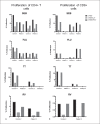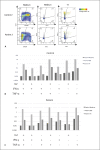Immunodeficiency in a Patient with 22q11.2 Distal Deletion Syndrome and a p.Ala7dup Variant in the MAPK1 Gene
- PMID: 32256297
- PMCID: PMC7109426
- DOI: 10.1159/000506032
Immunodeficiency in a Patient with 22q11.2 Distal Deletion Syndrome and a p.Ala7dup Variant in the MAPK1 Gene
Abstract
The genetic basis for sporadic immunodeficiency in patients with 22q11.2 distal deletion syndrome is unknown. We report an adult with a type 1 (D-F) 22q11.2 distal deletion syndrome and recurrent severe infections due to herpes zoster virus, presenting mild T cell lymphopenia and diminished frequency of naive CD4+ T cells, but increased frequencies of central, effector, and terminally differentiated memory T cells. Antigen-specific CD4+ and CD8+ T cells to influenza, rotavirus, and SEB were conserved in the patient, but responses to tetanus toxoid were temporarily undetectable. Exomic sequencing identified the c.20_22dupCGG (NM_002745.4) variant in the remaining MAPK1 gene of the patient, which adds 1 alanine to the polyalanine amino-terminal tract of the protein (p.Ala7dup). The mother, unlike the father, was heterozygote for the variant. Western blot analysis with the patient's activated PBMCs showed a 91% reduction in the MAPK1 protein. Further studies will be necessary to determine whether or not the variant present in the remaining MAPK1 gene of the patient is pathogenic.
Keywords: 22q11.2 distal (D–F) deletion syndrome; Immunodeficiency; MAPK1; T lymphocytes.
Copyright © 2020 by S. Karger AG, Basel.
Conflict of interest statement
The authors have no conflicts of interest to declare.
Figures



References
-
- Beddow RA, Smith M, Kidd A, Corbett R, Hunter AG. Diagnosis of distal 22q11.2 deletion syndrome in a patient with a teratoid/rhabdoid tumour. Eur J Med Genet. 2011;54:295–298. - PubMed
-
- Bengoa-Alonso A, Artigas-Lopez M, Moreno-Igoa M, Cattalli C, Hernandez-Charro B, Ramos-Arroyo MA. Delineation of a recognizable phenotype for the recurrent LCR22-C to D/E atypical 22q11.2 deletion. Am J Med Genet A. 2016;170:1485–1494. - PubMed
-
- Burnside RD. 22q11.21 Deletion syndromes: a review of proximal, central, and distal deletions and their associated features. Cytogenet Genome Res. 2015;146:89–99. - PubMed
LinkOut - more resources
Full Text Sources
Research Materials
Miscellaneous

